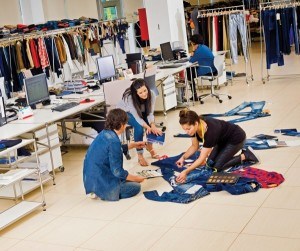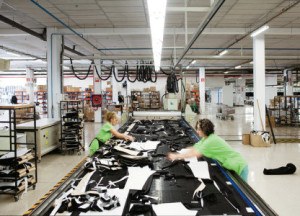How Zara uses supply chain to execute business model
Does HBS have case about Zara? If yes, I can bet it is about supply chain that in alignment with business model makes Zara the undisputed leader in fashion retail industry with over $14.8 billion in annual sales and over $9.4 billion in brand value.

The retailer provides wide range of fashionable, well-made, and relatively cheap pieces of clothing in fast fashion market across 88 countries. Zara focuses on 18-40 year old women with middle range income who are following fashion trends and update their wardrobe each season.
Since the margins in such business are low (6-10% gross margin in recent 4 years [1]) Zara puts efforts to cover the maximum number of potential consumers through vast chain of own stores in prime locations, web shops, social media (23,5 million followers in Facebook). For the last decade, the retailer has opened at least one new store every day [2].
Company’s value proposition lies in both design and speed – industry analysts argue that no other company reacts to fashion trends and turns trends into actual shipments to stores as quickly as Zara. The whole production cycle – from initial design to point of sale – takes Zara around two weeks while competitors spend six months in average to introduce new product to the market [3].
Why Zara is so fast? The company created innovative manufacturing process allowing quickly responding and selling clothes to its stores. Zara controls key components of its supply chain: designing, manufacturing, distribution, and retailing.
Designing
Zara employs army of designers who work in teams on tasks assigned by computer systems that determine potential trends in consumers demand [4]. Computers give preliminary information on what and how to design. Designers also got daily sales data and customers’ feedback on current production line items to incorporate improvements in new collections. Teams compete with each other – design supervisors identify the winners. Zara reshuffles teams every few months and assures that in two years most of the designers are different: employees with lower scores get fired after several team rotations, employees with higher scores get promoted to supervisor stages.

Manufacturing
Zara uses just in time production process with focus on in-house manufacturing [5] which enables company to be more responsive to demand changes. Zara uses frequent in-season assortment changes – company produces 50-60% of clothes in the start of the season. Retailer leaves some capacity for extra shifts in times of rapid demand changes and typically operates 4.5 days per week on full capacity.

Distribution
Back in 2005, Zara’s warehouse employees examined shipment requests sent by every store to determine needed shipments [6]. As operations increased, company started to develop new decision process based on a large-scale Operations Research model that determined every single shipment to stores based on stock levels and demand [7]. Before full-scale implementation of new model, Zara conducted a pilot experiment to test it. The results of the experiment showed that the Operations Research model increased in-season sales by at least 3-4% and reduced transshipments between stores. Since forecasting process was automated, Zara was able to optimize size of warehouse inventory allocation team to 60 employees worldwide.
Distribution is highly centralized with all items going through Spain. Shipments to retail stores go out twice a week – insane frequency for fashion retailer [8].
Retailing
Zara’s network is vast – over 2000 stores worldwide. Zara does not prioritize customer service – management knows that consumers will come anyway because they cannot find the same trend, price and range of products anywhere else. There is no advertising as well – Zara relies on word-of-mouth promotion strategy. The only promotion tool it uses is prime store locations close to luxury brands. Every store is equipped with Point-of-sale system analyzing what is selling and what is not. Every hour store generates reports on sales in order to replenish the stock [9].
To support its business model of leading fast-fashion retailer Zara has built vertically integrated supply chain focused on quick and flexible designing and manufacturing, frequent distribution and vast retailing. This operating model enables to change collections frequently and adapt to rapid demand changes while covering vast customer base. Business and operating models are closely matched. Does it work for Zara? To my opinion, the financial results speak for themselves [1]!
[1] http://www.marketwatch.com/investing/stock/zara/financials
[2] http://www.ft.com/cms/s/2/a7008958-f2f3-11e3-a3f8-00144feabdc0.html#slide0
[4] https://www.quora.com/What-is-it-like-to-be-a-designer-with-Zara
[5] https://www.tradegecko.com/blog/zara-supply-chain-its-secret-to-retail-success
[7] “Zara Uses Operations Research to Reengineer its Global Distribution Process”, 2009
[9] http://www.slideshare.net/navinshan/retailing-report-on-zara-clothing-store



Great read Alina! What I really like about Zara is that even in the retail space where inventory is a big challenge given the large number of SKUs, they have been able to reduce inventory while at the same time launching new designs twice every week! Achieving this fine balance would not have been possible without the RFID tracking on their SKUs for instant analytics on demand trends, JIT and the soft launch trials for new designs. Having experienced Zara in Dubai and London, I do think that all designs were not available even in a shopping hub like Dubai but am not sure if it was on purpose based on the regional demand or the delay in merchandise reaching there due to centralized distribution.
Love this post! Zara is definitely one of my favorite stores. You mentioned that there’s a centralized design team. I wonder if the teams are split by geographic regions as fashion trends tend to differ in different countries, or do they try to aim for common designs that would appeal to everyone?
I’m also curious about their manufacturing process. We learned in class that usually new products lead to higher defect / lower quality because the processes are so new, and it takes some time / multiple batches before the quality improves. Is this the case for clothing as well? Since they have so many designs I wonder how they ensure quality is up to par when they have so many different SKUs and rotating items every few weeks…
Awesome post Alina, I almost wrote about Zara myself!
If I remember correctly, another key factor in Zara’s success is its use of cross-functional teams in its initial design phase. Similar to what we saw in the IDEO case, Zara really encourages quick feedback and prototyping early on to achieve its amazing turnaround turn – Zara’s designers, product/market specialist, planning staff, and prototype shop are often located in one room.
Similar to what others have mentioned, I wonder how its operating model changes for different product categories. In addition to potentially tailoring to local tastes, I imagine that another major divide would be stable/basic items vs. trendy items. As the supply and demand for stable/basic items are likely more consistent, I imagine the processes you described are more applicable to its trendy items. Thanks for a great read Alina!